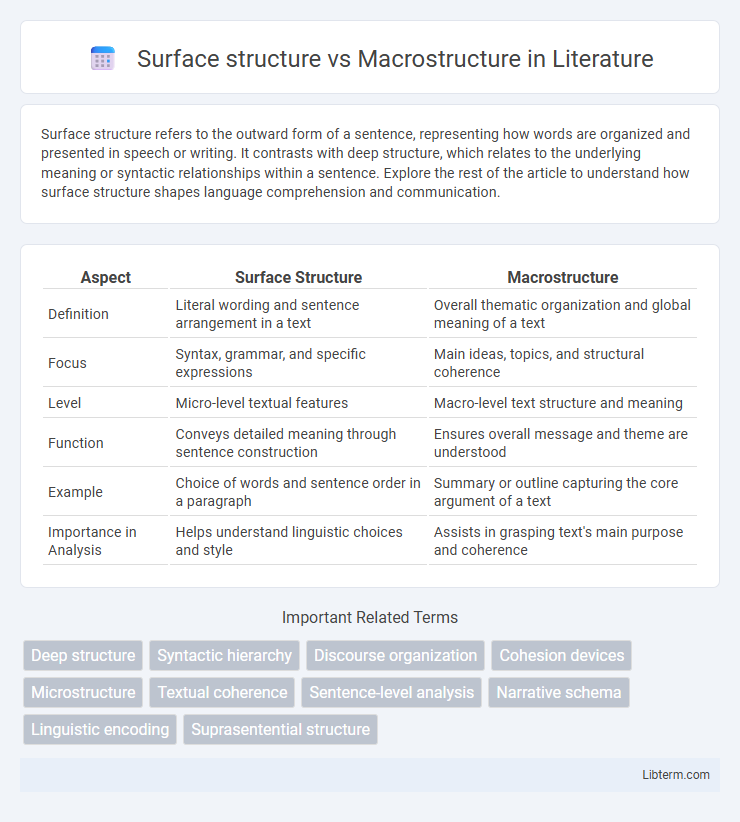Surface structure refers to the outward form of a sentence, representing how words are organized and presented in speech or writing. It contrasts with deep structure, which relates to the underlying meaning or syntactic relationships within a sentence. Explore the rest of the article to understand how surface structure shapes language comprehension and communication.
Table of Comparison
| Aspect | Surface Structure | Macrostructure |
|---|---|---|
| Definition | Literal wording and sentence arrangement in a text | Overall thematic organization and global meaning of a text |
| Focus | Syntax, grammar, and specific expressions | Main ideas, topics, and structural coherence |
| Level | Micro-level textual features | Macro-level text structure and meaning |
| Function | Conveys detailed meaning through sentence construction | Ensures overall message and theme are understood |
| Example | Choice of words and sentence order in a paragraph | Summary or outline capturing the core argument of a text |
| Importance in Analysis | Helps understand linguistic choices and style | Assists in grasping text's main purpose and coherence |
Introduction to Surface Structure and Macrostructure
Surface structure refers to the concrete organization and specific details of a text, including sentence structure, word choice, and paragraph order. Macrostructure involves the overall framework and global meaning, highlighting main ideas and the hierarchical relationship between concepts in a text. Understanding both surface structure and macrostructure is essential for analyzing how information is presented and how the text's broader message is conveyed.
Defining Surface Structure in Writing
Surface structure in writing refers to the visible form of text, including sentence arrangement, word choice, and punctuation that shape the immediate readability and coherence of a passage. It contrasts with macrostructure, which encompasses the overarching organization and thematic framework of the entire text. Effective control of surface structure enhances clarity and stylistic expression while supporting the underlying macrostructural intent.
Understanding Macrostructure in Texts
Macrostructure in texts refers to the overarching framework that organizes main ideas and themes, enabling readers to grasp the global meaning beyond individual sentences. Understanding macrostructure involves recognizing patterns such as topic sentences, headings, and paragraph organization that guide the interpretation of key concepts and the text's overall purpose. This comprehension enhances reading efficiency by aiding in summarization, inference, and retention of essential information.
Key Differences Between Surface Structure and Macrostructure
Surface structure refers to the specific wording and sentence arrangement in a text, emphasizing syntax and grammar, while macrostructure involves the overall organization, including main ideas and thematic progression. Surface structure operates at the sentence level, shaping how information is presented, whereas macrostructure concerns the global coherence and the hierarchical framework guiding the entire discourse. Key differences highlight that surface structure deals with linguistic form, and macrostructure focuses on content organization and meaning at a broader level.
The Role of Surface Structure in Readability
Surface structure in text refers to the specific words, sentence syntax, and overall linguistic presentation that directly impact readability by influencing how easily a reader can decode and comprehend the information. Clear word choice, short sentences, and familiar vocabulary enhance immediate understanding, reducing cognitive load and improving reading speed. Effective manipulation of surface structure is crucial for accessibility, especially in educational materials and technical documents where clarity is paramount.
How Macrostructure Shapes Content Organization
Macrostructure shapes content organization by providing a coherent framework that governs the arrangement of ideas, ensuring clarity and logical flow throughout the text. It emphasizes the overall theme and main points, guiding readers through the underlying message rather than isolated sentences or phrases found in the surface structure. This hierarchical organization enhances comprehension by connecting individual elements into a unified and purposeful narrative.
Surface Structure: Common Features and Elements
Surface structure in linguistics refers to the literal arrangement of words and sentences as they appear in text or speech, encompassing syntax, word order, and phrase structure. Common features include grammatical construction, punctuation, and sentence length, which directly affect readability and clarity. Elements such as clauses, phrases, and lexical choices serve as the building blocks shaping the observable form of communication before deeper semantic or thematic analysis.
Macrostructure: Patterns in Narrative and Expository Writing
Macrostructure in narrative and expository writing refers to the overarching framework that organizes ideas into a coherent whole, distinguishing it from surface structure which deals with sentence-level details. Patterns in macrostructure include chronological sequencing, cause-effect relationships, problem-solution arrangements, and classification, all of which guide readers through complex information logically and enhance comprehension. Effective use of these macrostructural patterns improves clarity and retention by structuring content around central themes and key points.
Impact of Structure Choices on Reader Comprehension
Surface structure, characterized by sentence-level elements such as syntax and word choice, directly influences immediate readability and clarity for the reader. Macrostructure, encompassing overall text organization like sections, headings, and thematic development, facilitates deeper understanding by providing a coherent framework that guides the reader through the content logically. Well-balanced sentence construction combined with a clear macrostructure significantly enhances reader comprehension, retention, and ability to synthesize information effectively.
Best Practices for Balancing Surface Structure and Macrostructure
Balancing surface structure and macrostructure requires careful attention to coherence and clarity at both the sentence and organizational levels. Best practices include ensuring sentence fluency and grammar accuracy to maintain an engaging surface structure while structuring paragraphs and sections logically to enhance macrostructure consistency. Employing clear topic sentences, transitions, and thematic progression supports a cohesive document that effectively communicates complex ideas.
Surface structure Infographic

 libterm.com
libterm.com